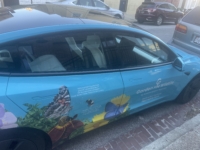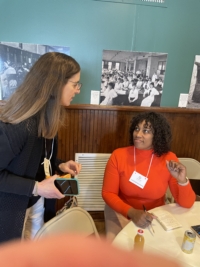
I finally got to meet Devin Thorpe at SuperCrowdBaltimore last week. As I noted a few weeks ago, he and I “met” at the height of the pandemic and have been working together on issues we both care about ever since. Of late, that has focused on how we can collaborate through the work he does to promote crowdfunded investment in companies promoting social change and what I do in grass roots peacebuilding.
So, it was a no brainer for me to go to the conference he organized that focused on the work along those lines that is already being done in Baltimore. It is, after all, only an hour away from me, and I knew that there was a lot going on there.
 So, I accepted a ride from Shubber Ali, founder and CEO of Garden for Wildlife, which I will focus on in next week’s post. So, all I’ll say here is that we had a delightful ride up I-95 in his Tesla which is pained in GFW’s colors and festooned with its logo.
So, I accepted a ride from Shubber Ali, founder and CEO of Garden for Wildlife, which I will focus on in next week’s post. So, all I’ll say here is that we had a delightful ride up I-95 in his Tesla which is pained in GFW’s colors and festooned with its logo.
Crowdfund Investing
If you have used sites like GoFundMe and haven’t used what is officially referred to as Regulation Crowdfund Investing, the first thing I have to do is to clear up a misconception. The campaigns that I’ve participated in on those platforms have mostly involved contributions to a person or a cause I believe it. Terrific, but I’m never going to see that money again.
For the last decade or so, it has become possible to for average citizens to invest as little as $100 in companies, most of which are small startups or growing companies that have yet to make the “big time.” Your investment can take a number of forms, typically either directly buying stock in the firm or making what amounts to a loan with clear repayment terms.
In either case, you get a stake in the company. If it fails, you will never see your money again as is the case with traditional crowdfunding. If it succeeds, you make money, just as you would had you invested in Amazon or Zoom at their IPO, neither of which, alas, I did.
It’s also easy to invest given the way the legislation was written for the United States. The industry is regulated through the Securities and Exchange Commission. Companies that want to raise funds do so by listing themselves on one of more than thirty on line platforms which lay out basic information about the firm and its offering and manage your investment, should you decide to make one. Garden for Wildlife is listed on DealMaker. RaiseGreen specializes in environmental and climate-related firms. Lists and reviews of the platforms are easy to find on the internet, and I’m far from qualified to comment on which of them makes the most sense. The platforms’ managers are expected to do due diligence on the companies that want to be listed on them.
It is a growing but still small phenomenon. About $1 billion was invested through those platforms in 2023 which is a drop in the bucked when compared to traditional investments which amounted to at least $150 billion last year. Through his work with The SuperCrowd, Devin is promoting the use of crowdfunding because it can be used to address any number of social needs, including giving relatively poor and middle class investors a chance to share in the so-called American dream of ownership. I’ve had the pleasure of reading an advance copy of the book Devin is publishing on the field, which should be out in the next few weeks.
The Night Before
I have a single criterion I use in determining if a conference was a success. Did I meet at least two people I want to get to know better?
I met that goal the night before the conference started when Devin hosted an informal dinner for people at the delightful R House which describes itself as “Baltimore’s launchpad for outsanding food and creating community.”
After I got my dinner (Korean), I sat down and introduced myself to Stephanie Geller, a force of nature who is the co-founder of Community Wealth Builders. I probably use the expression force of nature, but, as I learned over the next twenty-four hours, she gives the term new meaning. For the last twenty-five years, she has worked to build social justice in her home town in more ways than I could hope to list. She seemed to know everyone and see how they fit even when the fit wasn’t obvious as was the case for a recently retired financial planner whom she had recently met at a college reunion. She helped run a session that featured Shubber and four of her clients who are using her local crowd funding platform to raise money for a training facility, an arepas restaurant, a microbrewery, and Maryland’s first Black-owned winery. When I talked about what we hoped to do with Peacebuiling Starts at Home, she understood immediately that she was a peacebuilder even though she never used that term and pointed out to me that every community we decide to work in will need someone like her who connects dots across initiatives without focusing on buildiner their own personal empire.
 A few minutes after I set down, John Brothers sat down and started talking with Stephanie’s husband (who is a circuit court judge) about tapping into the social capital that is present in a court room among the jurors who are sitting around waiting to find out if they would be called that day. I, of course, had no idea who John was but soon learned that he was head of the T. Rowe Price Foundation and the company’s charitable arm (the two are not the same), I then learned that they did amazing work. In the last year, the foundation had given $6.5 million in multi-year, general support to 140 Baltimore based NGOs some of which they had worked with for as long as fifteen years. They looked for grantees who understood that they had to build social capital through relationships based on trust that focus less on a community’s problems but that learns how to build constructive solutions. When I mentioned Join or Die, the documentary on Bob Putnam’s work which I wrote about a few weeks ago, his only questions was how he could a copy and use it in his work, because he understood the value of what Putnam calls bridging social capital.
A few minutes after I set down, John Brothers sat down and started talking with Stephanie’s husband (who is a circuit court judge) about tapping into the social capital that is present in a court room among the jurors who are sitting around waiting to find out if they would be called that day. I, of course, had no idea who John was but soon learned that he was head of the T. Rowe Price Foundation and the company’s charitable arm (the two are not the same), I then learned that they did amazing work. In the last year, the foundation had given $6.5 million in multi-year, general support to 140 Baltimore based NGOs some of which they had worked with for as long as fifteen years. They looked for grantees who understood that they had to build social capital through relationships based on trust that focus less on a community’s problems but that learns how to build constructive solutions. When I mentioned Join or Die, the documentary on Bob Putnam’s work which I wrote about a few weeks ago, his only questions was how he could a copy and use it in his work, because he understood the value of what Putnam calls bridging social capital.

Key Themes
When I walked into the conference itself which was held at the iconic B and O Railroad Museum, I feared it might be anticlimactic. I had no reason to worry.

We spent a lot of time, too, learning about the potential as well as the problems of Baltimore. Living just outside of the city’s media market, I tend to hear about the problems—racial and wealth disparities in particular. However, I was only vaguely aware of the fact that it has a vibrant business community (like T. Rowe Price), a strong educational sector, and one of the highest concentrations of people with professional degrees in the country.
More importantly, we heard discussion after discussion of dazzling initiatives in a city whose national press is not all that positive. That started with a presentation about the Climate Access Fund which is one of three Green Banks in Maryland that is committed to making solar power accessible to Marylanders from all social backgrounds. Next weekend, for example, construction will begin on a project that will install solar panels on the roof of a school in a predominantly Black neighborhood that will generate enough energy to power 175 homes in the area at a reduced rate that will also provide opportunities for residents to own part of the project. The fund was able to raise a large proportion of the capital it needed for that an other projects through Raise Green which is one of the platforms through which a company can raise funds from small investors. Stephanie had her fingers in that project, of course.
Organizations that I would not have expected to support for growing BIPOC and women owned businesses through crowdfunding made remarkable presentations, including the Chamber of Commerce and the Baltimore Economic Development corporation. Both have programs that do everything from repaint the facades of commercial buildings to attracting high tech companies that want to serve the city’s diverse communities.
We heard from an attorney who moved from Washington DC to Baltimore and learned quickly that his real estate dollars went a lot farther because he moved forty miles to the north. So, he has put together teams of investors in the Black professional community who are buying and restoring not just individual buildings, but entire blocks, including in the area surrounding the railroad museum. In the process, not only are they improving the housing stock, but they are investing in their own community in ways that will also make it easier for residents to purchase those homes and begin developing more of their own wealth.
Stephanie also has her fingers in one of the country’s first locally based and locally owned crowdfunding investment platform and a group that is seeking to revitalize an entire neighborhood by including lower income residents in the pool of investors who will eventually benefit from the redevelopment. Her crowd funding network has already helped over 90 businesses raise $1.5 million for about 13,000 investors.
Three Takeaways
As the day wore on, I realized that crowdfunding, per se, is not the real goal, at least for my purposes. It is a tool that can help us achieve a variety of goals, including racial and economic inequality in a city like Baltimore.
It also led me to refocus the work I do as a member of Devin’s Impact Cherub club which meets monthly to consider two or three companies we might consider investing in. I realized that we have reviewed two kinds of companies. First are relatively large regional or national groups like Garden for Wildlife, which I’ve found fairly easy to assess. Second are the kinds of local, smaller initiatives we learned about in Baltimore. They are far harder to assess, far more likely to fail, but more in keeping with my peacebuilding nad social change strategies. Going forward, I plan to focus on those local startups and help Devin and others develop ways of predicting how they are likely to do and, thus, determine whether or not we should invest in them.
Last but by no means least, I saw the Importance of finding people like Stephanie and John as we try to get Peacebuilding Starts at Home projects up and running around the country. It may not require a single individual like either of them. Still, as we’ve seen with the Portland Rotary group on racial healing which Gretchen and I attend, it really helps to have one or a handful of local entrepreneurs who have the contacts and the skills to connect more and more of the dots in their communities.
The views and opinions expressed in this article are those of the author and do not necessarily reflect the official policy or position of the Alliance for Peacebuilding or its members.
